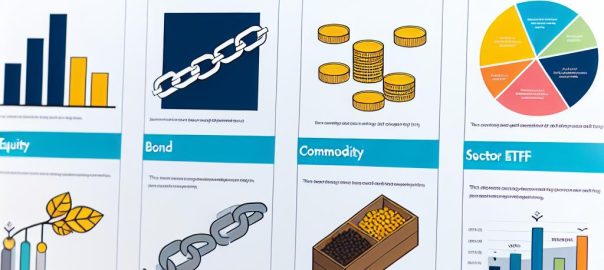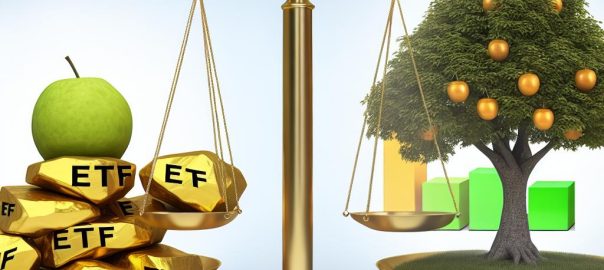The Basics of ETFs
Exchange-Traded Funds (ETFs) are investment funds that trade on stock exchanges, much like stocks. They hold assets such as stocks, commodities, or bonds and generally operate with an arbitrage mechanism designed to keep trading close to its net asset value. ETFs offer a way for investors to gain exposure to a diverse range of asset classes, sectors, or regions. These funds have garnered considerable attention from both individual investors and institutions due to their flexibility and potential benefits over other types of investment vehicles.
How ETFs Work
ETFs are structured like mutual funds but traded like individual stocks on an exchange, meaning they can be bought and sold throughout the trading day. They are composed of a basket of assets, allowing investors to own a fraction of that basket through the purchase of ETF shares. This structure allows ETFs to offer both intraday liquidity and a variety of investment options, making them a versatile tool for various investment strategies. Intraday liquidity means that investors can react quickly to market changes by buying or selling shares whenever the exchange is open, unlike mutual funds, which typically only allow redemptions at the end of the trading day.
Benefits of ETFs in Diversification
One primary advantage of using ETFs for diversification is their ability to provide broad market exposure. Whether an investor is looking for exposure to a specific sector, such as technology or healthcare, or a specific geographic region, such as emerging markets or Europe, there is likely an ETF that matches that preference. This wide selection of options allows investors to tailor their portfolios to their own risk tolerance and investment goals.
ETFs also offer cost-effectiveness compared to mutual funds, as they often have lower expense ratios and fewer management fees. This is advantageous for investors who seek to minimize costs while achieving diversification. Over time, even small differences in fees can significantly impact an investment’s total return, making the cost efficiency of ETFs a noteworthy benefit.
Sector and Geographic Diversification
ETFs enable investors to diversify across various sectors or regions. For instance, an investor can purchase an ETF that focuses on technology companies or one that aggregates stocks from multiple countries. This diversified exposure can mitigate risks associated with investing heavily in a single sector or region. For example, if one sector is performing poorly, gains in another sector within the ETF could help buffer overall losses.
Fixed Income and Commodity Diversification
ETFs also provide access to fixed income and commodities. Investors interested in bond markets can invest in bond ETFs, which may contain government, corporate, or municipal bonds. Commodities ETFs, on the other hand, allow investors to gain exposure to resources like gold, oil, or agricultural products without having to directly invest in physical assets. This allows investors to hedge against inflation or economic instability, as commodity prices often move inversely to stock markets during turbulent times.
Rebalancing and Tax Efficiency
ETFs can simplify the rebalancing process for portfolios. Since they encapsulate numerous assets within a single fund, adjusting allocations is often quicker as compared to individual stocks or bonds. This can be particularly useful for maintaining a desired asset allocation or exposure to specific market sectors over time. Moreover, ETFs are generally considered to be tax-efficient because they tend to incur fewer capital gains distributions than mutual funds. ETFs achieve this tax efficiency through a process called in-kind creation and redemption, which minimizes the need to sell securities and trigger capital gains taxes.
Considerations When Investing in ETFs
Before investing in ETFs, consider factors such as the underlying index or asset, the cost in terms of expense ratio, and liquidity, which refers to how easily shares can be bought or sold. ETFs that track well-known indices, such as the S&P 500 or the FTSE 100, tend to have high liquidity, meaning there is a lot of market activity, which facilitates buying or selling shares at market prices. Conversely, ETFs focusing on niche markets may experience less liquidity.
It’s also essential to assess the specific risks associated with the ETF’s focus, whether sector-specific or geographically concentrated. For instance, an ETF that targets a volatile sector like biotechnology could see significant price swings, while an ETF that invests in emerging markets might be exposed to political or economic instability.
Conclusion
ETFs are versatile investment tools that can significantly enhance diversification within a portfolio. They provide various options that cater to different investment strategies and goals. By understanding the structure and benefits of ETFs, investors can make informed decisions and create a well-rounded investment portfolio. The combination of flexibility, cost-effectiveness, and potential tax advantages make ETFs a valuable component of both small and large portfolios.
For more detailed information about the range of available ETFs and strategies for incorporating them into your investment portfolio, consult a financial advisor or visit reliable financial news sources and platforms focused on investment research and analysis. Additionally, continually monitor the performance and alignment of ETFs with your investment objectives, as the financial landscape and personal goals may evolve over time.







